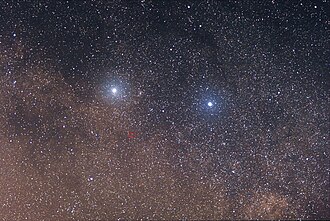by Dilip D’Souza

The star Proxima Centauri has been in the news this August. One reason is actually as a sort of corollary, a side mention. Proxima Centauri, Alpha Centauri A and Alpha Centauri B are the stars that make up the star system we know as Alpha Centauri: a triple star system, though without a telescope, we see it as one star.
Now such a system is fascinating enough by itself, but the real reason Alpha Centauri interests us Earth folks is that it is the closest “star” to us apart from our Sun – about 4.5 light years away. And of the three, Proxima Centauri is actually the closest. And, as a red dwarf, it’s the smallest, the coolest, the … in fact, deadest of the three. That’s because red dwarf stars are close to the end of their lives.
This August, a team of astronomers used the James Webb Space Telescope (JWST) to discover a planet orbiting Alpha Centauri A. Not only that, it looks like the planet is in Alpha Centauri A’s “habitable zone”, meaning it’s at least possible there might be life there. (I wrote about that discovery here.)
Why is the Alpha Centauri A planet a reminder of Proxima Centauri? Because while this planet is new to us, we’ve known for a few years now that three planets orbit Proxima. Which means that of the nearly six thousand so-called “exoplanets” – planets outside our Solar System – we know of today, these three are the closest to us. What’s more, one of them is in Proxima’s habitable zone. (That particular exoplanet prompted this column, but it returns only near the end.)
It should be no surprise that there are scientists who put those facts together and think: Can we humans get there? Can we live there? Read more »


